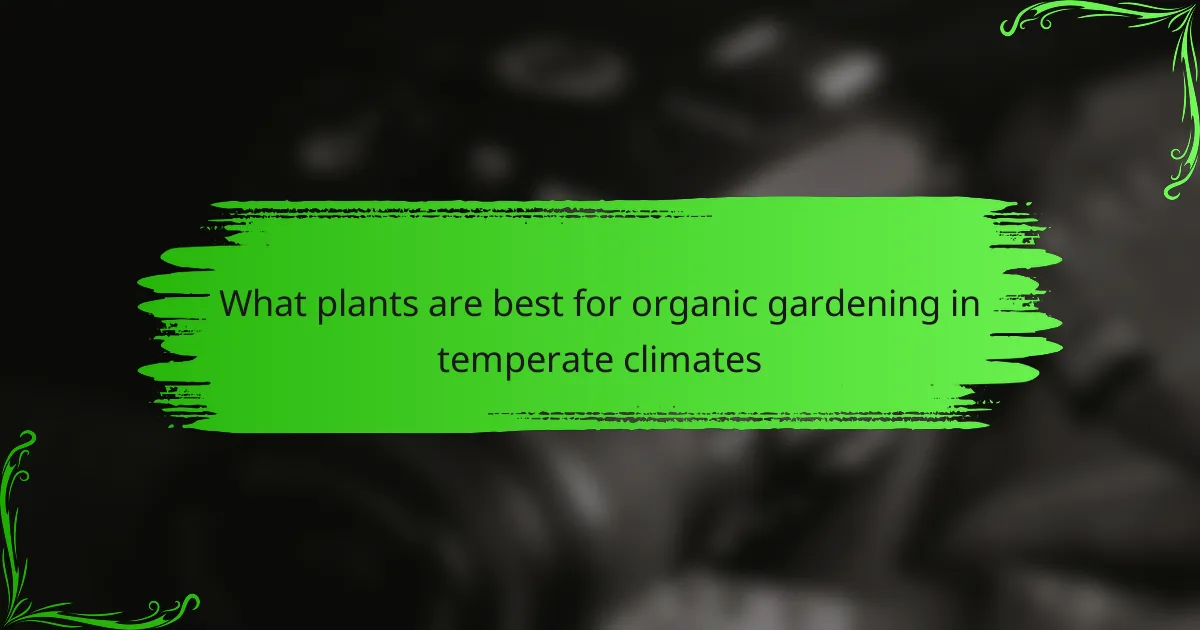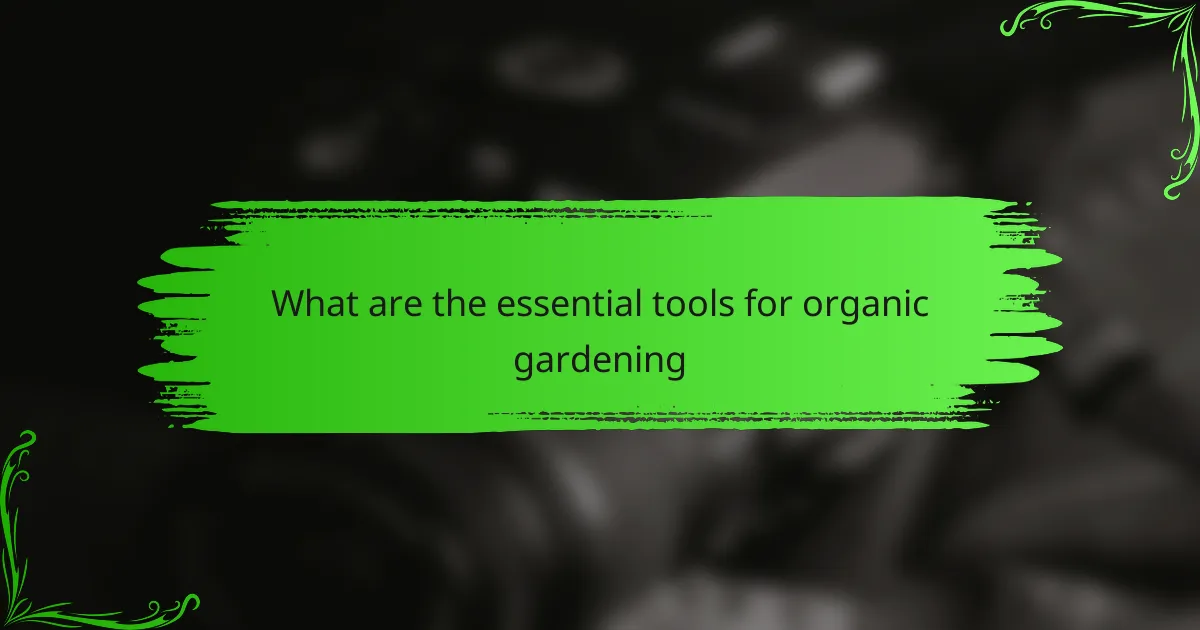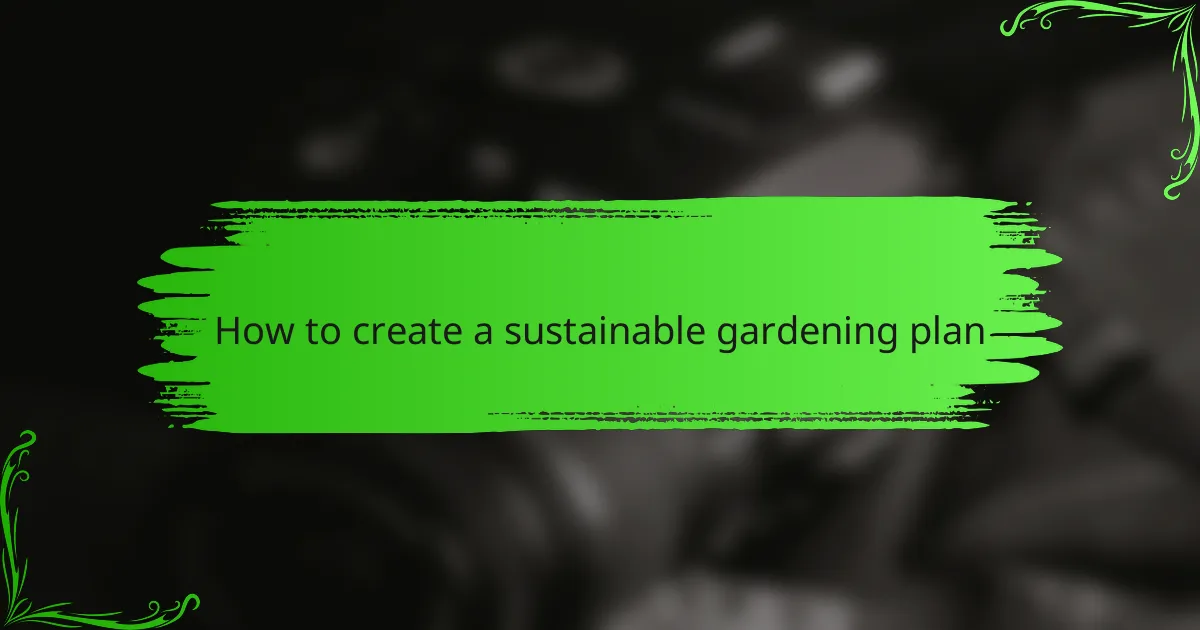Organic gardening offers a sustainable way to cultivate plants while being mindful of your budget. By prioritizing necessary tools, tracking expenses, and selecting native species or heirloom vegetables, you can create a thriving garden that enhances biodiversity. Additionally, focusing on soil health is crucial, as it supports plant growth and resilience, ensuring a successful gardening experience.

How to budget for organic gardening in urban areas
Budgeting for organic gardening in urban areas involves careful planning and resource management to maximize your gardening potential while minimizing costs. Focus on tracking expenses, prioritizing necessary tools, and utilizing local resources to create a sustainable and cost-effective gardening practice.
Use a detailed expense tracker
Keeping a detailed expense tracker is essential for managing your organic gardening budget. Record all costs associated with seeds, soil amendments, tools, and maintenance to understand where your money goes. This will help you identify areas where you can cut back or invest more wisely.
Consider using a simple spreadsheet or a budgeting app to categorize your expenses. Regularly reviewing your spending can reveal patterns and help you adjust your budget as needed, ensuring you stay within your financial limits.
Prioritize essential gardening tools
Investing in essential gardening tools is crucial for efficient organic gardening. Focus on acquiring high-quality, multi-functional tools that will last longer and perform better, such as a sturdy spade, hand trowel, and pruners. This can save you money in the long run compared to purchasing cheaper, less durable options.
When budgeting for tools, consider second-hand options or borrowing from local gardening groups. This approach can significantly reduce costs while still providing you with the necessary equipment to maintain your garden effectively.
Plan seasonal planting schedules
Creating a seasonal planting schedule helps you optimize your gardening efforts and budget. By planning when to plant specific crops, you can take advantage of seasonal price fluctuations for seeds and soil amendments. This strategy also allows you to stagger your harvests, ensuring a continuous supply of fresh produce.
Research local climate conditions and choose crops that thrive in your area. This not only enhances your yield but can also reduce the need for costly inputs like fertilizers and pest control, ultimately saving you money.
Utilize community gardening resources
Community gardening resources can provide valuable support for urban organic gardeners. Many cities have community gardens, workshops, and local gardening clubs that offer shared tools, seeds, and knowledge. Engaging with these resources can significantly reduce your gardening costs.
Look for local gardening events or online forums where you can connect with fellow gardeners. Sharing tips, seeds, and even produce can foster a sense of community while also helping you stay within your budget.

What plants are best for organic gardening in temperate climates
In temperate climates, the best plants for organic gardening include native species, heirloom vegetables, and pollinator-friendly flowers. These plants are well-suited to local conditions, promote biodiversity, and can enhance the overall health of your garden.
Choose native plants for resilience
Native plants are adapted to the local environment, making them more resilient to pests and diseases. They typically require less water and maintenance compared to non-native species, which can lead to cost savings in gardening.
When selecting native plants, consider species that thrive in your specific region. For example, in the United States, plants like coneflowers and black-eyed Susans are popular choices for their hardiness and ability to attract beneficial insects.
Opt for heirloom vegetable varieties
Heirloom vegetables are open-pollinated varieties that have been cultivated for generations, often prized for their flavor and nutritional value. Growing heirlooms can provide a diverse range of produce that is well-suited for organic gardening.
Look for heirloom varieties that are known to perform well in your climate. For instance, tomatoes such as Brandywine and Cherokee Purple are favorites among gardeners for their rich taste and adaptability to various growing conditions.
Incorporate pollinator-friendly flowers
Pollinator-friendly flowers are essential for attracting bees, butterflies, and other beneficial insects that help with plant reproduction. Including these flowers in your garden can improve yields and enhance biodiversity.
Consider planting a mix of flowers that bloom at different times throughout the growing season. Species like lavender, bee balm, and zinnias not only provide nectar but also add visual appeal to your garden.

How to maintain soil health in organic gardens
Maintaining soil health in organic gardens is essential for promoting plant growth and sustainability. Healthy soil is rich in organic matter, nutrients, and beneficial microorganisms, which together support robust plant development and resilience against pests and diseases.
Implement crop rotation techniques
Crop rotation involves changing the types of crops grown in a specific area over time to improve soil health and reduce pest buildup. By rotating crops, you can prevent nutrient depletion and disrupt the life cycles of pests and diseases that thrive on specific plants.
For example, following a nitrogen-fixing crop like legumes with heavy feeders such as tomatoes can enhance soil fertility. A simple rotation plan might include rotating between legumes, leafy greens, and root vegetables each season.
Use organic compost for nutrient enrichment
Organic compost enriches soil by adding essential nutrients and improving its structure. Compost is made from decomposed organic materials like kitchen scraps, yard waste, and manure, which provide a slow-release source of nutrients for plants.
To effectively use compost, apply a layer of 2-3 inches to your garden beds in the spring or fall. Ensure that the compost is well-aged to avoid introducing pathogens or weed seeds into your garden.
Test soil pH regularly
Regular soil pH testing is crucial for maintaining optimal soil health, as pH affects nutrient availability to plants. Most vegetables thrive in slightly acidic to neutral pH levels, typically between 6.0 and 7.0.
Testing kits are widely available and can provide results within minutes. If your soil is too acidic, consider adding lime; if it’s too alkaline, sulfur can help lower the pH. Aim to test your soil at least once a year, especially before planting seasons.

What are the essential tools for organic gardening
Essential tools for organic gardening include hand tools, raised garden beds, and pest control methods that align with organic practices. These tools not only enhance efficiency but also support sustainable gardening efforts.
Invest in quality hand tools
Quality hand tools are crucial for effective organic gardening. Look for durable options like stainless steel trowels, pruners, and hoes that can withstand regular use without rusting or breaking.
Consider investing in ergonomic designs to reduce strain during long gardening sessions. Brands that focus on sustainability often offer tools made from recycled materials, which can be a great choice for eco-conscious gardeners.
Consider raised garden beds for efficiency
Raised garden beds improve soil drainage and can extend the growing season by warming up faster in spring. They also reduce the need for bending, making gardening more accessible for individuals with mobility issues.
When building raised beds, consider using untreated wood or recycled materials to avoid chemical leaching into the soil. Standard dimensions are often 4 feet wide and 6 to 8 inches deep, allowing for easy access and maintenance.
Utilize organic pest control methods
Organic pest control methods help maintain a healthy garden without harmful chemicals. Techniques include introducing beneficial insects like ladybugs, using neem oil, or creating barriers with row covers to protect plants.
Regular monitoring is essential to catch pest issues early. Consider companion planting, where certain plants are grown together to naturally deter pests, enhancing both plant health and yield.

How to create a sustainable gardening plan
Creating a sustainable gardening plan involves setting clear objectives, selecting appropriate plants, and maintaining healthy soil. This approach ensures that your garden thrives while minimizing environmental impact and resource use.
Set long-term gardening goals
Establishing long-term gardening goals helps you stay focused and organized. Consider what you want to achieve, such as growing your own food, enhancing biodiversity, or creating a habitat for wildlife.
Break down your goals into manageable steps. For example, if your aim is to produce vegetables, plan for crop rotation, seasonal planting, and pest management strategies. Regularly review and adjust your goals based on your progress and changing circumstances.
Incorporate permaculture principles
Permaculture principles emphasize working with nature to create self-sustaining ecosystems. Start by observing your garden’s natural patterns, such as sunlight, water flow, and existing plant life, to inform your design.
Implement techniques like companion planting, which involves growing mutually beneficial plants together, and using mulch to retain moisture and suppress weeds. These methods can enhance soil health and reduce the need for chemical inputs.

What are the benefits of organic gardening
Organic gardening offers numerous advantages, including improved soil health, enhanced biodiversity, and reduced chemical exposure. By using natural methods, gardeners can cultivate healthier plants and contribute to a more sustainable environment.
Budgeting strategies for organic gardening
Effective budgeting is crucial for successful organic gardening. Start by estimating costs for seeds, soil amendments, tools, and pest control methods. Consider using a spreadsheet to track expenses and identify areas where you can save.
To minimize costs, prioritize purchasing organic seeds and local soil amendments. Buying in bulk can also reduce expenses significantly. Additionally, consider starting a compost pile to recycle kitchen scraps and yard waste, which can lower your need for store-bought fertilizers.
Plant selection for organic gardening
Choosing the right plants is essential for a thriving organic garden. Opt for native species or heirloom varieties that are well-adapted to your local climate and soil conditions. These plants often require less maintenance and are more resilient to pests and diseases.
When selecting plants, consider their growth habits and compatibility with each other. Companion planting can enhance growth and deter pests. For example, planting marigolds alongside vegetables can help repel harmful insects.
Soil health in organic gardening
Soil health is the foundation of organic gardening, as it supports plant growth and nutrient uptake. Focus on building healthy soil through practices like crop rotation, cover cropping, and adding organic matter such as compost or well-rotted manure.
Regular soil testing can help you understand nutrient levels and pH, guiding your amendments. Aim for a balanced soil structure that promotes aeration and water retention. Avoid using synthetic fertilizers, as they can disrupt soil biology and lead to long-term degradation.
